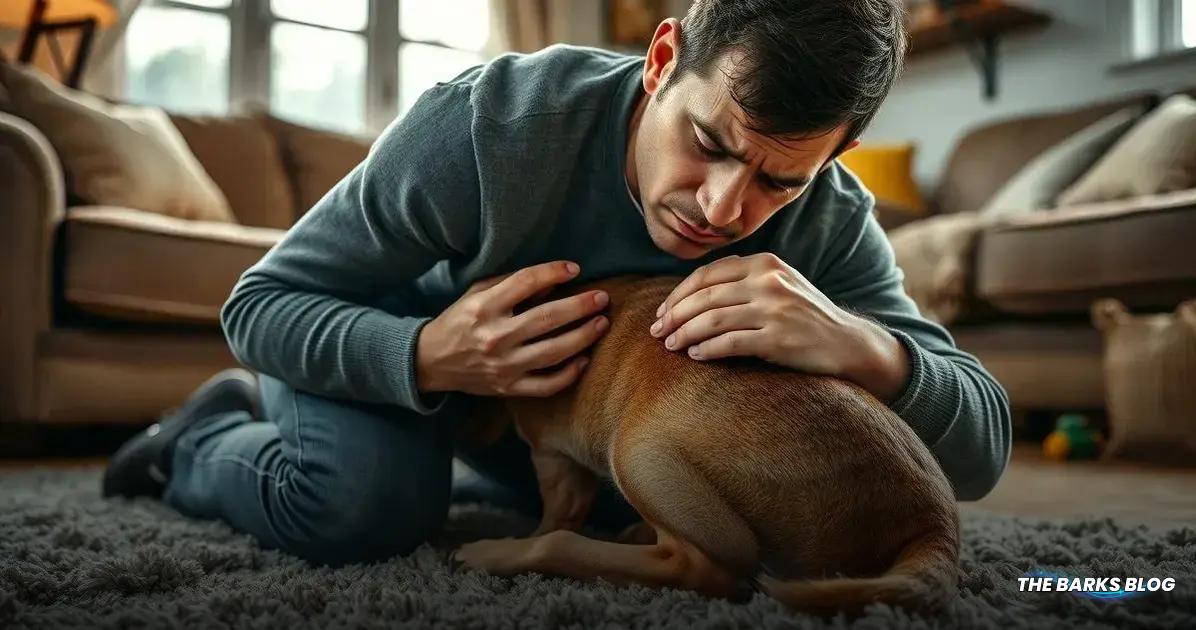Allergy bumps in dogs are raised skin areas caused by the immune system reacting to allergens, leading to discomfort. Diagnosis requires a veterinarian’s evaluation, while treatment includes medications, allergen avoidance, immunotherapy, and dietary changes to improve skin health.
If you’re a dog owner, you may have noticed bumps on your dog’s skin at some point. These bumps can be a sign of dog allergies, causing discomfort and irritation. Understanding the causes and treatments is essential for your dog’s well-being.

Understanding Allergy Bumps
Allergy bumps on dogs are a common concern for pet owners. These bumps, often caused by the immune system’s reaction to allergens, can vary in appearance and severity. Understanding what these bumps are and how they form is crucial for effective treatment.
When a dog encounters an allergen—whether through inhalation, ingestion, or direct contact—the immune system may overreact. This reaction leads to the release of histamines and other chemicals that cause inflammation and fluid accumulation in the skin layers, resulting in the formation of bumps.
These bumps can manifest in different forms, including hives, vesicles, or pustules, each indicating a different type of allergic response. Hives, for instance, are red, raised bumps that can appear suddenly and may be itchy. They often resolve quickly, but their sudden appearance can be alarming for pet owners.
Understanding the underlying cause
of these bumps is vital. Factors such as food allergies, environmental allergens, and flea bites can all lead to similar symptoms. Therefore, recognizing the signs and seeking veterinary advice is essential for accurate diagnosis and effective treatment.
By being aware of what allergy bumps are and how they develop, dog owners can take proactive steps to manage their pet’s health and comfort.

Types of Skin Bumps in Dogs
When it comes to skin bumps in dogs, there are several types that can arise due to allergies or other conditions. Understanding these different types can help pet owners identify the issue and seek appropriate treatment.
Hives (urticaria): Hives are red, raised bumps that can appear suddenly on a dog’s skin. They are usually itchy and can occur as individual bumps or in clusters. Hives can disappear just as quickly as they appear, making them a common but often fleeting symptom of an allergic reaction.
Vesicles: Vesicles are small blisters filled with clear fluid. These bumps often appear in clusters and are typically associated with contact allergies. Vesicles can be uncomfortable for dogs and may require treatment to alleviate irritation.
Pustules: Pustules are small, elevated bumps filled with pus, which is a thick fluid made up of dead white blood cells and bacteria. These bumps are often a result of localized bacterial infections and can indicate folliculitis, which involves inflammation of the hair follicles.
Other Skin Changes: Allergies can also cause various skin changes that might not resemble typical bumps. These changes can include erosions or ulcers (open sores), crusts and scabs, or dry, flaky skin. While not bumps per se, these conditions can still indicate underlying allergic reactions and require attention.
Recognizing these different types of skin bumps is crucial for pet owners. If you notice any unusual bumps or changes in your dog’s skin, consulting a veterinarian is essential for accurate diagnosis and effective treatment.

How Allergic Reactions Cause Skin Changes
Allergic reactions in dogs can lead to various skin changes, including the formation of bumps. Understanding how these reactions occur is key to managing your dog’s health.
When a dog encounters an allergen—be it through inhalation, ingestion, or direct contact—the immune system identifies this substance as a threat. In response, the immune system releases chemicals like histamines and cytokines. Histamines are responsible for triggering common allergy symptoms such as itching, swelling, and redness.
The sequence of events in an allergic reaction can be broken down as follows:
- Exposure: The dog first comes into contact with the allergen. This could happen through various means, such as eating certain foods, inhaling pollen, or touching irritating substances.
- Immune Response: Upon exposure, the immune system overreacts, releasing histamines and cytokines. Histamines cause blood vessels to dilate, leading to increased blood flow to the affected area, which results in redness and swelling.
- Fluid Accumulation: As the immune response continues, fluid may accumulate in the skin layers, causing bumps to form. This fluid buildup is a direct result of the inflammation triggered by the histamines.
- Scratching and Further Irritation: As the dog experiences itching due to the bumps, they may scratch the affected areas. This scratching can lead to additional skin damage, further complicating the situation and potentially leading to secondary infections.
Understanding this process helps pet owners recognize the signs of allergic reactions and seek timely veterinary care. Proper management of allergies can significantly improve a dog’s quality of life and reduce the occurrence of uncomfortable skin changes.

Differentiating Allergy Bumps from Other Conditions
Distinguishing between allergy bumps and other skin conditions in dogs can be challenging, as many issues can present similarly. However, understanding the differences can lead to a more accurate diagnosis and effective treatment.
Here are some common conditions that may be confused with allergy bumps:
Flea Bites
Flea bites are usually seen as small red dots rather than raised bumps. However, flea bite allergies can cause small, red bumps or raised lesions, typically located on the lower back, tail base, and hindquarters. This reaction is due to the dog’s sensitivity to flea saliva and can lead to intense itching and hair loss.
Mange
Mange, caused by mites, can result in red, scaly, or crusty skin, along with hair loss and severe itching. The bumps associated with mange are often localized to specific areas, such as the edges of the ears, elbows, and abdomen. A veterinarian can perform a skin scraping test to confirm the presence of mites.
Bacterial or Yeast Infections
Skin infections may lead to pustules, sores, or crusting. These bumps are often accompanied by a foul smell, oozing discharge, or hair loss. A veterinarian can conduct tests, such as impression smears, to confirm the type of infection.
Ringworm
Ringworm is a fungal infection that causes circular areas of hair loss with red, raised edges. The skin may appear scaly, and lesions can form on various body parts. Diagnosis typically requires a veterinarian’s evaluation.
Hot Spots (Acute Moist Dermatitis)
Hot spots are localized, inflamed, and painful sores that develop quickly, often due to a secondary infection where bacteria enter damaged skin. These areas can be moist and require prompt treatment to alleviate discomfort.
Mast Cell Tumors
Mast cell tumors are a type of cancer that can appear as single or multiple lumps on the skin. These tumors may grow rapidly and can be itchy or uncomfortable for the dog. Any unusual or growing skin bump should be examined by a veterinarian for accurate diagnosis.
Given the variety of conditions that can mimic allergy bumps, consulting a veterinarian is crucial for proper evaluation and treatment. Only a professional can provide the necessary tests and insights to differentiate between these conditions and ensure your dog receives the appropriate care.

Diagnosing Skin Problems Caused by Allergies
Diagnosing skin problems caused by allergies in dogs requires a thorough evaluation by a veterinarian. Given the complexity of skin conditions, a systematic approach is essential for accurate diagnosis and effective treatment.
Here’s how the diagnostic process typically unfolds:
- Detailed History Taking: The veterinarian will begin by gathering a comprehensive history of the dog’s health. This includes asking about the onset of symptoms, any changes in diet, exposure to new environments or products, and previous medical history. Understanding the timeline of the bumps and any accompanying symptoms can provide valuable clues.
- Physical Examination: A thorough physical examination of the dog will be conducted. The veterinarian will assess the appearance and location of the bumps, as well as look for other signs of allergies or skin conditions, such as redness, swelling, or signs of infection.
- Diagnostic Tests: Depending on the findings, the veterinarian may perform several tests to identify the underlying cause of the skin bumps. Common tests include skin scrapings to check for mites, cytology to examine cells from the skin, and allergy tests to identify specific allergens.
- Biopsy (if necessary): In some cases, a biopsy of the affected skin may be required. This involves taking a small sample of skin tissue for laboratory analysis to rule out other conditions, such as tumors or infections.
- Allergy Testing: If allergies are suspected, the veterinarian may recommend allergy testing. This can be done through blood tests or intradermal skin tests, which involve injecting small amounts of allergens into the skin to observe reactions.
- Food Elimination Trials: For suspected food allergies, a veterinarian may suggest an elimination diet. This involves removing certain ingredients from the dog’s diet for a period of time to see if symptoms improve, followed by reintroducing them one at a time.
Once other causes have been ruled out, allergies are often identified as the most likely culprit behind the skin bumps. The veterinarian will then discuss suitable treatment options based on the specific allergens and the dog’s individual needs.
Early and accurate diagnosis is crucial for managing skin problems effectively. By understanding the diagnostic process, pet owners can take proactive steps to ensure their furry friends receive the best possible care.

Effective Treatment Options for Allergy Bumps
Treating allergy bumps in dogs involves a comprehensive approach that focuses on relieving symptoms, managing the underlying allergies, and preventing future flare-ups. Here are some effective treatment options:
- Symptomatic Relief: Your veterinarian may prescribe medications to help alleviate itching and inflammation caused by the allergies. Antihistamines, corticosteroids, or other anti-inflammatory drugs can provide quick relief from discomfort.
- Allergen Avoidance: Identifying and avoiding allergens is crucial in managing allergy bumps. This may involve changing your dog’s diet to a hypoallergenic formula, reducing exposure to environmental allergens (like pollen or dust), or using pet-safe cleaning products and fabrics.
- Immunotherapy (Allergy Shots): Immunotherapy involves administering small amounts of the identified allergens to gradually desensitize the dog’s immune system. This process can help reduce the severity of allergic reactions over time.
- Biological Therapy: This innovative treatment mimics the dog’s immune system to neutralize the primary proteins responsible for itching. Biological therapy can be particularly effective for dogs with chronic allergies.
- Regular Bathing and Grooming: Regular baths (every 1-2 weeks) using hypoallergenic or medicated shampoos can help remove allergens and irritants from the skin, as well as treat secondary skin infections. It’s important to thoroughly rinse the products to avoid leaving residue on the skin.
- Flea Control: For dogs with flea bite allergies, effective flea control is essential. This includes using flea prevention products year-round to prevent allergic reactions and managing any existing flea infestations.
- Omega-3 Fatty Acid Supplements: Adding omega-3 fatty acids to your dog’s diet can improve skin health and reduce inflammation associated with allergies. These supplements can help alleviate symptoms and promote overall well-being.
- Protective Clothing: In some cases, especially for dogs with environmental or contact allergies, wearing protective clothing (such as doggy shirts or booties) can help reduce exposure to allergens or irritants.
It’s important to remember that every dog has unique allergies, so treatment plans should be customized to their specific needs. Managing and providing long-term relief for your dog’s allergy bumps requires patience, consistency, and effective care. In challenging cases, consulting with a veterinary dermatologist may be necessary for specialized treatment options.
Conclusion
Managing allergy bumps in dogs is crucial for their comfort and overall health. By understanding the causes and types of these bumps, pet owners can take proactive steps to identify and treat the underlying issues.
Effective treatment options, ranging from medication to dietary changes and allergen avoidance, can significantly alleviate symptoms and improve your dog’s quality of life.
It’s essential to consult with a veterinarian for accurate diagnosis and tailored treatment plans, ensuring that your furry friend receives the best care possible.
With the right approach, you can help your dog stay happy, healthy, and free from the discomfort of allergy bumps.
FAQ – Frequently Asked Questions about Dog Allergy Bumps
What are allergy bumps in dogs?
Allergy bumps in dogs are raised areas on the skin that occur as a result of the immune system’s reaction to allergens. They can be itchy and vary in appearance.
How can I tell if my dog has allergy bumps?
Signs of allergy bumps include red, raised areas on the skin, itching, and possible swelling. If you notice these symptoms, it’s best to consult a veterinarian for an accurate diagnosis.
What causes allergy bumps in dogs?
Allergy bumps are caused by the dog’s immune system overreacting to allergens such as pollen, certain foods, flea bites, or environmental irritants.
How can I treat my dog’s allergy bumps?
Treatment options include medications for itching and inflammation, allergen avoidance strategies, immunotherapy, and regular bathing with hypoallergenic shampoos.
Are allergy bumps serious?
While allergy bumps can cause discomfort, they are not usually serious. However, if your dog shows signs of severe allergic reactions, such as difficulty breathing, seek immediate veterinary care.
Can I give my dog over-the-counter allergy medication?
Some over-the-counter medications, like Benadryl, can help with mild allergy symptoms, but you should always consult a veterinarian before administering any human medication to your dog.




